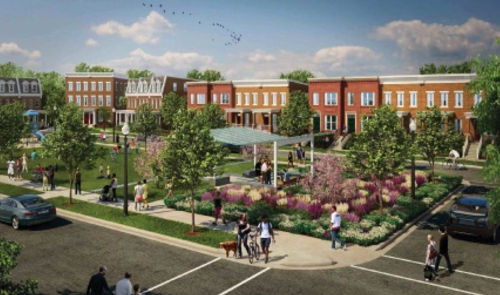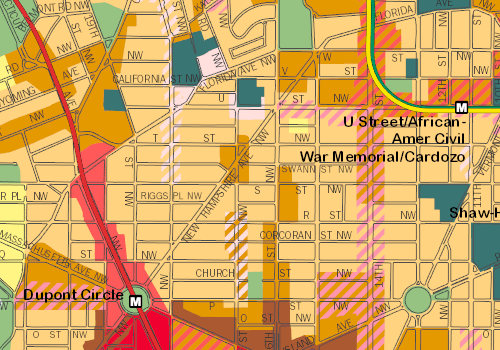Why the Office of Planning likes PUDs (and why you should too)

Part of the plans for the Park Morton redevelopment. Image by Park View Community and District of Columbia.
At last Wednesday’s oversight hearing for the Office of Planning, Director Eric Shaw drew a clear line between the agency’s recent proposals to amend the Comp Plan and addressing the legal issues holding up thousands of homes and affordable homes in Planned Unit Developments (PUDs) around the city. In doing so, Shaw illustrated why PUDs are such an important tool for the city.
OP says PUDs have done a lot for the city, especially when it comes to affordable housing
Planned Unit Developments (PUDs) are a particular development process in DC where an applicant can receive zoning flexibility and relief in exchange for a set of community benefits negotiated with the city and the neighborhood. PUDs create an extra layer of community input not present in matter-of-right development. The developer and the neighborhood must come to an agreement on what extra benefits will be included in the project, which can include things like infrastructure improvements for the neighborhood or additional affordable housing.
In his written testimony, Director Shaw explained that during just last year OP managed 47 PUD and Zoning Commission design review cases combined:
“Altogether, the cases represented all parts of the city and account for over 18.5 million square feet of new development, including:
- Almost 13,100 new housing units, including 2,530 affordable units
- Almost 600 hotel rooms;
- 4.6 million square feet of office space; and
- Almost 1 million square feet of retail space.”
Shaw explained that those 2,350 affordable units are “four times the number of Inclusionary Zoning (IZ) units that would have been yielded through matter-of-right development alone.” In other words, without using PUDs, these same projects would have only brought the city around 580 affordable homes.
Part of the plans for the Park Morton redevelopment, a project to replace one-for-one 53 units of dilapidated public housing on Georgia Avenue. Park Morton and the connected project at Bruce Monroe are in limbo due to a legal challenge to the project's PUD. Image by Park View Community and District of Columbia.
Shaw and his team also explained that due to DC law regarding commercial development, “[commercial] PUDs led to a total of almost $9 million in contributions to the Housing Production Trust Fund.” The DC government, in recent years, has maintained that fund at $100 million, meaning that PUD-related contributions from private developers accounted for almost 10 percent last year.
The flexibility and community input process involved in PUDs also creates other benefits besides affordable housing such as environmental sustainability measures and green space, as noted by Shaw:
“Thirty-three of the FY 17 PUDs have committed to LEED Gold or Green Communities construction, and they include at least 600,000 square feet (over 13.5 acres) of new green roofs and over 22 acres of publicly accessible park or plaza space.”
The new West End library and its related projects brings 164 homes and 55 affordable homes to a wealthy area of downtown. Its PUD was challenged, but eventually the case was dismissed. Other cases remain in question today. Image by TEN Arquitectos used with permission.
Despite this, PUDs are in trouble
There are a few reasons everyone is talking about PUDs nowadays. First, developers are applying for more and more of them in recent years, particularly in neighborhoods that have high land values or are seeing an increase in land values. The reality is that there are not that many “easy plots” left to develop in DC’s high value areas. Neat squares that are flat and/or vacant have been already built upon.
What is left are more complicated projects that require a bit more zoning flexibility to pencil out, or projects that developers consider higher risk and are only willing to take on if they can use a PUD to gain that flexibility and extra land value.
The other news about PUDs is that they are being appealed to the courts at historic levels. After a series of successful appeals in Brookland and at the McMillan Sand Filtration site, the number of legal challenges has skyrocketed. By current count, as many as 5,000 homes and almost 500 affordable homes are on hold because the projects' PUD applications have been appealed to the US Court of Appeals.
Part of the reason these appeals have all of sudden been successful has to do with the Comprehensive Plan. In particular, there have been legal questions about the intent of the language in one of the Comp Plan’s two central maps, the Future Land Use Map (FLUM).
A portion of the Future Land Use Map. Competing interpretations of this map and its definitions have led to a historic surge of lawsuits. Image by DC Office of Planning.
OP wants to clarify a decade-old interpretation of the Comp Plan
Because of this, Shaw explained in his testimony that OP’s recently released amendments to the Comp Plan sought to “clarify and affirm” the role of PUDs and the relevant Comp Plan language, in keeping with the agency’s long-standing interpretation of both. According to him, the changes proposed align the Comp Plan with how the Office of Planning and the Zoning Commission have been interpreting the document for years, thus giving needed clarification to the courts and to communities. He explained:
“In so doing, we ensure the PUD process can continue to serve as an effective tool for preserving and producing affordable housing and other key public benefits. Over the last five years, PUDs have resulted in the approval of nearly 6,000 affordable housing units, which is 3,500 affordable units above what IZ regulations would have required alone. It is essential that we continue this progress.”
OP might make PUDs even better
Shaw concluded his remarks by suggesting there were other changes to the Comp Plan’s Framework Element that the agency is considering supporting. Noting many meetings with council staff and community stakeholders, he stated that:
“[T]he common message we have heard is a desire to expand the narrative about affordable housing and displacement. The Office of Planning has taken this recommendation to heart. We are acutely aware and concerned about the threat to affordability in the District and associated pressures that contribute to displacement of residents. We have begun considering important additions to the Framework that will further emphasize challenges in the District’s housing sector, and look forward to honing language through the legislative process.”
This would be good news. GGWash has been working with a diverse coalition of housing stakeholders to advocate for amendments to the Comprehensive Plan (this post represents my own writing and is not a statement from the coalition). The stated priorities of this group have been to ensure that the city has more homes (enough for the 1 million residents OP projects we’ll have by 2045), has enough affordable homes, and that the Comp Plan protects residents from direct displacement.
We will get a chance to see the new direction of the Comp Plan at the upcoming March 20th hearing on these amendments. If you’d like to support in advocating for a better Comp Plan, you can sign the coalition’s priorities statement to stay updated on more opportunities to engage in this important discussion. You can also join me for a Q&A conference call to get answers about these proposals. Click below to RSVP and get more info.
